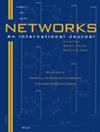利用PQ‐树实现聚类旅行推销员问题的可行性
IF 1.3
4区 计算机科学
Q4 COMPUTER SCIENCE, HARDWARE & ARCHITECTURE
引用次数: 0
摘要
设H=⟨V,𝒮⟩ 是超图,其中V$$V$$是一组顶点𝒮 是一组簇S1,…,Sm$${S}_1,\点,{S}_m$$,Si⊆V$${S}_i\substeq V$$,使得𝒮 不一定是不相交的。本文考虑可行性聚类旅行推销员问题,用FCTSP$$FCTSP$$表示。在FCTSP$$FCTSP$$中,我们的目标是确定是否存在只访问每个顶点一次的简单路径,以便连续访问每个簇的顶点。我们关注没有可行解路径的超图,并考虑从簇中移除顶点,使得具有新簇的超图对于FCTSP$$FCTSP$$具有可行解路径。该算法使用PQ树数据结构,并在线性时间内运行。本文章由计算机程序翻译,如有差异,请以英文原文为准。
Achieving feasibility for clustered traveling salesman problems using PQ‐trees
Let H=⟨V,𝒮⟩ be a hypergraph, where V$$ V $$ is a set of vertices and 𝒮 is a set of clusters S1,…,Sm$$ {S}_1,\dots, {S}_m $$ , Si⊆V$$ {S}_i\subseteq V $$ , such that the clusters in 𝒮 are not necessarily disjoint. This article considers the feasibility clustered traveling salesman problem, denoted by FCTSP$$ FCTSP $$ . In the FCTSP$$ FCTSP $$ we aim to decide whether a simple path exists that visits each vertex exactly once, such that the vertices of each cluster are visited consecutively. We focus on hypergraphs with no feasible solution path and consider removing vertices from clusters, such that the hypergraph with the new clusters has a feasible solution path for FCTSP$$ FCTSP $$ . The algorithm uses a PQ‐tree data structure and runs in linear time.
求助全文
通过发布文献求助,成功后即可免费获取论文全文。
去求助
来源期刊

Networks
工程技术-计算机:硬件
CiteScore
4.40
自引率
9.50%
发文量
46
审稿时长
12 months
期刊介绍:
Network problems are pervasive in our modern technological society, as witnessed by our reliance on physical networks that provide power, communication, and transportation. As well, a number of processes can be modeled using logical networks, as in the scheduling of interdependent tasks, the dating of archaeological artifacts, or the compilation of subroutines comprising a large computer program. Networks provide a common framework for posing and studying problems that often have wider applicability than their originating context.
The goal of this journal is to provide a central forum for the distribution of timely information about network problems, their design and mathematical analysis, as well as efficient algorithms for carrying out optimization on networks. The nonstandard modeling of diverse processes using networks and network concepts is also of interest. Consequently, the disciplines that are useful in studying networks are varied, including applied mathematics, operations research, computer science, discrete mathematics, and economics.
Networks publishes material on the analytic modeling of problems using networks, the mathematical analysis of network problems, the design of computationally efficient network algorithms, and innovative case studies of successful network applications. We do not typically publish works that fall in the realm of pure graph theory (without significant algorithmic and modeling contributions) or papers that deal with engineering aspects of network design. Since the audience for this journal is then necessarily broad, articles that impact multiple application areas or that creatively use new or existing methodologies are especially appropriate. We seek to publish original, well-written research papers that make a substantive contribution to the knowledge base. In addition, tutorial and survey articles are welcomed. All manuscripts are carefully refereed.
 求助内容:
求助内容: 应助结果提醒方式:
应助结果提醒方式:


